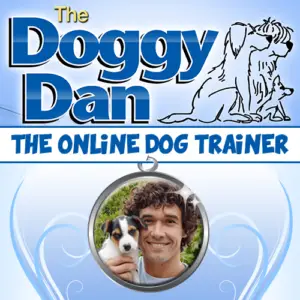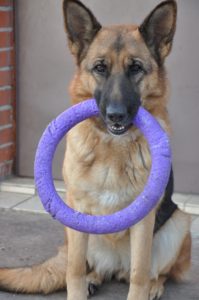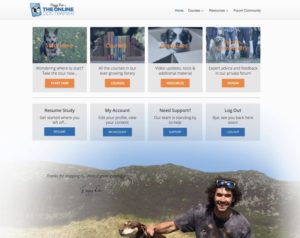I am Tiara Nixon and I am a certified dog trainer based in California.
Today I’m going to be reviewing the Online Dog Training program, by Doggy Dan.
To begin my Doggy Dan review, i’d like to give you an insight into my background to hopefully show you that I have a lot of experience in the field of dog training!
I have been training dogs since 1996, but my love of working with dogs began as a teenager, when our family German Shepherds were in obedience class. I started my training career as a PetsMart certified trainer and underwent an apprenticeship with a locally well-known trainer and competitor.
I have worked with hundreds of dogs. I strove to gain experience in all facets of dog care, so I could provide the best, up to date advice to my client families.
In the early 2000’s I was a zookeeper for the Houston Zoo where I performed stage shows, spoke at elementary schools, and created an educational curriculum for the Children’s Zoo. During this time, I never stopped training dogs! (Being a dog trainer is a little like being a doctor or lawyer- once someone finds out what you do, they start asking for advice!)
I got another certification through Animal Behavior and Training Associates and continued to offer private training.
I fell into dog training accidentally. I grew up with dogs (as well as cats, horses, fish) but it was when my mother acquired a beautiful German Shepherd that my passion for training began.
I was 15, and we enrolled in an obedience class at our local Humane Society.
Prior to this class we had trained dogs the way everyone did- leaving them loose in the house, rubbed their nose in their accidents when they happened, screamed and yelled when they were ”bad”.
Thinking back on it, it’s heartbreaking the way it was common place to abuse dogs.

Through the puppy obedience class (and some of the best written books of that time) we discovered crate training! We discovered planning! Using the dog’s instincts to train! And while methods of that time were still correction based, it was eye opening.
It was 6 years later that I would get an opportunity to be PAID to become a Dog Trainer through, what was then, an intensive dog trainer program at PetsMart.
Anyone can train dogs, but it takes a unique personality to be a dog trainer. What is the difference, you ask? Someone who trains dogs does just that- trains a dog.
A dog trainer is someone who is an expert at training dogs but has the ability to train the people dogs live with!
I aspired to be the most well rounded dog trainer I could be, gaining a wide assortment of experience such as vet assistant, adoption counselor at 2 animal’s shelters, groomer and pet food expert.
I was a foster parent for rescue organizations, fun show judge, and was on the forefront of training in agility and rally obedience.
Alas, as much as I’m enjoying my 5 minutes of fame, you didn’t come to this review to learn about me, so let’s get into this Doggy Dan Review!
So Who Is Doggy Dan – The Online Dog Trainer?
Doggy Dan is a New Zealand based dog trainer who is endorsed by the New Zealand SPCA. He is a celebrity trainer in his neck of the planet, having been featured on many tv and radio shows.
It is easy to understand how Dan became well known; in his videos he is down to earth, confident and polite.
He does not come across as a know-it-all, and he gives a lot of the credit of success to his dog Peanut.
Why Is an SPCA Endorsement a Good Thing?
The Society for the Prevention of Cruelty to Animals does not take endorsement lightly. As their name implies, they do not support anything that is deemed harmful or cruel, in any way, to animals.
Dan is a proponent of adoption, having adopted at least 3 dogs from the SPCA. Originally from the UK, he did not set out to become a dog trainer.
In fact, like my own story, he came by it accidentally. On his main dog training site Dan provides a timeline of his experience.
His mother was afraid of dogs; therefore, he was not allowed to have one as a child. He writes “I always loved dogs and found them no matter where we were”.
He went to school to be a civil engineer and worked in several fields before he found his calling.
It was after several life changing events- moving to New Zealand, getting married, and buying a house- that Dan acquired Peanut and was set on the path to dog training stardom.

On Dan’s About page he says that, like me, he read many books, watched videos/DVD’s and “took courses” with trainers all over the world. I wish he would have elaborated more on his experience, this would certainly have given him more credibility in my eyes.
Anyone with good looks and smart marketing can sell products, but is the product really worth buying?
Dan writes as though he invented the methods he uses, but really, dog trainers have been providing a hybrid version of pack theory for years. These were mostly trainers who didn’t believe that using harsh, aversive methods was the right way to go.
Ease of use/ Key Features of Doggy Dan’s Training Course
The site is clean, streamlined and easy to navigate. There is a handy video tutorial which shows you all the features and how to use them.
I found this to be a VERY helpful addition as a lot of times there is a massive amount of content and it is difficult to find. That is certainly not the case with Doggy Dan’s Online Dog Training.
There are A LOT of videos! The first course has 3 videos in the introduction alone! It’s clear that Dan wants to make sure all the information is conveyed, in some instances you can listen to audio versions of the content.
After you watch all the videos on a lesson you must mark it complete before you can move onto the next. You are assigned points for each lesson you complete and unlock achievements.
I honestly felt this to be a bit tedious as I was interested in jumping around and watching videos and was unable to do without going to the bottom of each page and marking it. However, overall it was still fairly easy to navigate.
How to Get Access to Doggy Dan’s Training Program
The modules as easy to get into once you have paid for your membership. You simply log in with your username and password, which are quickly emailed to you (I got mine within minutes of purchase).
The welcome screen has colorful graphics to guide you, or you can use the menu bar at the top of the page.
There is also an app you can download which may be helpful for those who prefer to train outside, or who train when on the go.
I did not have a chance to download the app but based on the ease of use of the website, I imagine the app is also clean and easy to use.
On Google Play the app only has 3 reviews- two of them are 5 star and one is 3 and none of them elaborate.
If you happen to use or have used the app, let me know a little more about it in the comment section below!
What Is Pack Training
Pack training, or pack theory, is leadership based training where your family unit- including your dog of course- takes on the structure of a pack.
Pack theory was first introduced in the 1960’s when a scientist studied captive wolves.
In his research he found there was a dominance hierarchy that was strictly adhered to, and it wasn’t long before trainers latched onto this information and began training dogs in this way.
This methodology has gained a lot of ground in recent years with the introduction of a celebrity trainer, but among professionals it is not considered the most up to date method of training.
One reason pack training has a bad wrap is that early in the use of type of training, harsh and aggressive methods were employed, such as forcing dogs into submission.

Doggy Dan does not use, or promote, use of force in any of his videos. In fact, he is often explaining that the trainer (you) remain calm when working through situations.
Pack based training is not a one-size-fits-all method. There are some dogs and breeds that are more sensitive and basic dog instinct is virtually bred out of them.
How do you handle these dogs? The other concern about this method is that it requires extreme consistency.
Until your dog is 100% on board with your rules, you MUST respond accordingly 100% of the time.
There isn’t much room for flexibility in training. So while you can get great results, if you can’t fully invest in training your dog WITH EVERY INTERACTION then this method may take a long time for you- or even backfire.
If you watch closely, you will see that every minute Dan is in the presence of a dog he is ON. This is how dogs are.
Their sight, smell and hearing are so superior to ours that we literally can’t even imagine what it’s like to see, hear and smell the way they do.
Dogs are masters of body language and they are highly adaptable, they are watching and learning at all times.
Pack theory essentially requires you to think and behave the way a dog would, so get ready to be ON every time your dog is around.
There is little room for error with this type of training. Many could argue with the advice I’m giving here, but the reality is, pack based training methods WILL take longer if you do not follow through 100% of time.
Dan reiterates many times throughout his videos the importance of follow through.
While follow through is important in ANY situation (including your children, spouse, coworkers, etc.) it is important for this methodology, as you will accidentally untrain your dog by being relaxed just ONCE.
Let me give you an example: one of Dan’s videos addresses whining in the crate. Is constant puppy crying which escalates in pitch and volume annoying?
Yes. Is it heartbreaking to think of your adorable little puppy locked up in a cage when all she wants is to be with you, her new mommy or daddy?
Yes. Let’s say little Poopsie is in the crate, whining and crying and you’re trying to relax and watch a movie. You’re exhausted, and you just want some quiet time to unwind.
Imagine it. Envision you’re on your comfy couch, comfortable, with your favorite show on. Then, hear the puppy doing that high pitched yelp/whine thing they do.
Are you still able to relax? Can you even hear the T.V. with incessant whining happening in the background?
For most dog people, the answer is no. They get puppy, plop her on the lap and continue to watch in peace. Or start playing with her. Or petting her.
The reality is, this ONE action just taught her that whining not only gets her out of the crate, but it also causes positive interactions- cuddling, petting or playing.
Do you see the point I’m trying to make? Just ONE act of relaxed dog training can undo days’ worth of work. Next time, little Poopsie will cry harder and louder, making sure you’re aware of her, to get what she wants.
There are many ways to solve this particular problem, and some are faster than others. This is one habit I want to cure FAST. How ‘bout you?
Doggy Dan’s 5 Golden Rules
 Doggy Dan has, what he terms, the 5 Golden Rules of establishing leadership with your dog.
Doggy Dan has, what he terms, the 5 Golden Rules of establishing leadership with your dog.
This is the first module in his training system and is used as the foundation for all the other modules. Below I review his golden rules in depth.
Rule #1: Food
I have to say up front that in 80-90% of the dogs I have worked with, the ones that showed an interest in dominating food often had a past that taught them this was a behavior to be reinforced. For other 10 or so percent, there were real dominance or aggression issues.
The idea behind this rule is that the pack leaders control all the food and always eat first. Therefore, to establish yourself as leader you must control all food, including edible chews. There is controversy over this.
Real World Example: I live with 2 adorable French Bulldogs, Desi and Rick. Desi is older, but Rick is intact (not neutered and therefore experiencing hormonal drivers). Rick is generally a very friendly, sociable dog- except when it comes to high value chews. In this scenario, he has been known to guard and even bite people!
So, does Rick think he is the leader? No. And here’s why: Desi is able to eat his food, take his bed, and even snatch up food that is dropped on the floor.
By Doggy Dan’s standards, Desi is the leader. What Rick is doing is resource guarding, and this behavior is consistent with any dog- without without perceived authority. In this case, Rick got some extensive training of “leave it” and he was rewarded with high value treats for not going after the thing he wanted.
Further study of cohesive WILD wolves has proven that the pack eats together. Once all adult members have eaten, the leader pair will then take ownership of what remains to feed their pups. A wolf pack is more like a family unit than it is a hierarchy.
Just like in a human family, the parents (or alphas) are always thinking about the good of the pack as a whole, not just what they can have for themselves.
In places throughout the site I noticed Dan promotes the desire to be #1 dog is there from birth and that “this is why the runt eats last”. I disagree with this. The runt eats last because he is the weakest.
Newborns care about only 2 things- being fed and staying warm. If you are the smallest puppy, your siblings are going to tromp on you for access to the food simply because you’re in the way- not because they want to be the alpha.
This early training for the runt, however, is typically reinforced and therefore the runt of the litter is generally less assertive.
Doggy Dan provides videos for what to do if your dog is food aggressive, feeding multiple dogs, and controlling high value toys.
I do not agree with his suggestion that we need to control the food. This could lead to aversive behavior in your dog and should not be attempted with dogs who are in way food protective or aggressive.
Rule #2: DANGER
This rule addresses the dogs need to protect his home, his people, himself.
Doggy Dan provides some very helpful tips and FAQ’s on how to get your dog to respect that you decide what should be viewed as “danger”.
Rule #3: Separation
 Ignoring your dog after separation is a key element in any training program. One of the biggest mistakes I witnesses in my years working with dog families is unintentional reinforcement. The easiest example of this is petting a fearful dog. We do it to provide comfort to our dog.
Ignoring your dog after separation is a key element in any training program. One of the biggest mistakes I witnesses in my years working with dog families is unintentional reinforcement. The easiest example of this is petting a fearful dog. We do it to provide comfort to our dog.
Since petting is a pleasurable experience, and dogs live in the moment, the dog sees the petting as a reward for being fearful. Sadly, this unintentionally teaches the dog that fear is a behavior to keep.
While we might be excited to see our dog after a long day at work, greeting them with excitement and pets when the dog is jumping, or barking only reinforces the negative behaviors. It tells the dog that you’re happy to be jumped on, barked at or greeted with over enthusiasm.
The videos Doggy Dan presents for this golden rule are well thought out, detailed and to the point.
Rule #4: Your Terms
As I mentioned previously, I was a proponent of pack theory as one the methods I used to train dogs. However, golden rule #4 is a skill I teach to EVERY dog family as it is the basis for good manners.
Dan shows you techniques for setting boundaries with your dog in a calm, and easy way.
Some dog owners may get frustrated at the pace of this task, but patience and 100% follow through are key.
Rule #5: The Essential Walk
This golden rule is what would be the “heel” lesson in most generic obedience classes. It’s no surprise to me that Dan includes learning to walk on a leash as one of the first lessons.
As a professional dog walker myself, walking dogs who do not have respect for the human is highly frustrating.
Also, it’s potentially dangerous if the dog pulls someone over or gets the lead out of your hands where he can get into traffic or be hurt by another dog.
Doggy Dan offers a lot of videos on this subject. I was impressed that he used an untrained dog with real leash issues to demonstrate his method.
It’s very easy to show a method with a well trained dog, but I feel the learning experience is better when you are able to see a real example.
He addresses things that will inevitably be a frustration in your training and helps you create a mind set that will help.
Summary of the 5 Golden Rules by Doggy Dan
When I got to the end of the The Dog Calming Code module, I was truly surprised!
There are bonus videos as well as a printable, full color worksheet for remembering the basics of the 5 golden rules.
I felt these extras were above and beyond my expectations which certainly adds value to the program.
What’s in Doggy Dan’s Online Dog Training Program?
I hope that I gave you a good overview of Doggy Dan’s method above, now I’m going to talk a little bit about the other courses in his program.
The Dog Calming Code is the first module, and I recommend starting there.
Other courses include: Everyday Tools & Techniques, Perfect Puppy, All Dog Problems Solved, and Dan’s Dog Training 101.
Everyday Tools & Techniques
The lessons in this module focus on, what I would term, safety training.
Here you will learn Dan’s technique for getting your dog to come to you reliably, dog behavior and how to use it to your advantage, and what to do with your dog when he or she won’t participate.
Dan provides useful tips to get your dog’s attention and diffuse situations.
The Perfect Puppy
There are 23 lessons in the Perfect Puppy module. Dan sets you up for puppy ownership such as discussing diet and altering your dog, addresses common problems with puppies and then provides some basic training options.
I tried to think of problem behaviors Doggy Dan doesn’t address, but honestly, I couldn’t. While not all of the lessons have videos, he does have information for pretty much anything you may experience when working with a puppy.
For example, he has a lesson on submissive urination- which is something many owners tolerate but don’t often have answers for solving.
Another lesson in The Perfect Puppy is crying when left. To address this topic when other training programs don’t is definitely a plus for Doggy Dan.
There is a lesson on Digging, I was impressed that Dan provides the reasons why dogs dig and how to use these reasons to prevent the behavior.
All Dog Problems Solved
Another module with A LOT of lessons, 25 in fact. Just about any dog issue you can imagine is addressed here, including many that don’t often get a lot of attention like, poop eating, obsessions, and barking in the car.
There is a case study of a dog aggressive dog, Cruz. I found it interesting to see how Dan handles an aggressive dog, though I was a bit disappointed he did not provide information on what signals the dog was giving that cause Dan to be cautious.
As a long time trainer, it is second nature for me to notice the little ways dogs communicate. The average or new dog owner often confuses signals- such as assertive tail wagging- and can make a situation worse by not knowing.
The videos did not capture why this dog was labeled a dog aggressive, only how Dan handles it. I would have liked if more information was provided on how to spot aggressive signals before the dog and owner are in the middle of a situation.
There is some helpful information in the videos, but with any kind of aggression I suggest getting the help of a professional in person. There are simply too many variables to “fix” aggression issues via video.
Dan’s Dog Training 101
 Another area that has a lot of lessons is Dog Training 101. Although the name suggests this would cover the basics, it doesn’t really focus on basic training. This module features lessons such as: Body Language, Shouting at Your Dog, Parenting and Dog Training, and Learning to Swim.
Another area that has a lot of lessons is Dog Training 101. Although the name suggests this would cover the basics, it doesn’t really focus on basic training. This module features lessons such as: Body Language, Shouting at Your Dog, Parenting and Dog Training, and Learning to Swim.
First, let me talk about the Body Language lesson. I went into this excited that Dan had made an entire lesson about dog speak (as I call it). However, I came through the lesson kind of disappointed.
Dogs are intelligent beings who have figured out numerous ways to communicate with us.
The more we understand THEIR language, the easier it is to spot potential problems situations, know when danger is real or imagined, know when a dogs playing is crossing into aggression, or when dominance is just playing.
In my training, I incorporate a great deal of dog speak lessons. Quite a bit of the time these lessons are unplanned as I like behavior to be witnessed organically.
I train all my clients to learn the universal language of dogs, and also to pay attention to the way their particular dog interacts with the world around him or her.
Dan does a good job of incorporating body language throughout his modules, but here, in a lesson dedicated to body language, I felt he was lacking.
Doggy Don’t: The Parenting and Dog Training Lesson
I was again a bit disappointed. I thought this may be an informative lesson on how to incorporate training into a busy schedule, but alas, it is merely a video of Dan being interviewed about a book he wrote on how you can apply his philosophies to parenting as well as dog training.
While this 4 minute interview is mildly interesting, I did not feel this was a “lesson” and could have been placed in a free area of the site.
While there are a lot of “lessons” this module comes across as a hodgepodge of videos that would have been better served in a resource format.
There are some “commands” offered in The Perfect Puppy if that is what you’re looking for, but in Dog Training 101, where you might expect to find it, you won’t.
There is a lot of redundancy in this module. He has a video showing how he stops a Boxer from jumping up, but this issue has its own lesson in Dog Problems Solved.
I would have liked to have seen Dan’s actual, hands on technique for teaching the basics to ADULT dogs, as opposed to what he offers in the Puppy module.
I’ve had a lot of large, exuberant older puppies come to me who will not easily back into a sit or slide into a down, but instead will go rump in the air, jump up, or hop back.
Project Moses
 In addition to the courses I’ve already described, Dan offers a diary course called Project Moses. This course offers 68 videos of his dog Moses and follows his training progress from puppy to adult.
In addition to the courses I’ve already described, Dan offers a diary course called Project Moses. This course offers 68 videos of his dog Moses and follows his training progress from puppy to adult.
I love this concept! Being able to watch as Moses grows and learns new lessons is so helpful. Seeing how he is shaped as he goes along will help many puppy owners realize what their dog can become if they are willing to put in the time and effort.
The course offers interesting videos such as “When Your Potty Training Falls Apart” and “Puppy Dominating Another Dog”. I particularly like the fact there are real world examples of what puppy ownership is like.
While I found it enjoyable to watch, and recommend it for those who are still in the considering stage of getting a dog, be warned that a lot of the videos in this portion are not instructional.
The Forum
Doggy Dan offers a forum where pet parents can ask questions. He claims that he is available to respond as well as “experts”.
I didn’t dive too deep into the forum, but I would like to know how often Dan responds personally to his client’s questions. While I’m sure he is busy, accessibility to the trainer providing the program is an important factor for me.
There will always be things that come up that are unique to your situation and your dog.
While being able to watch videos and see training “in action” is certainly better than trying to interpret what the correct behavior will look like from a book, even videos can’t cover every possible troubleshooting scenario.
Dog Training Books Vs Videos
Let’s divert for a minute and talk about book versus video training. I have read many books on the subject of training.
My library includes basic training, advanced training, agility, scent work, service dog training, hearing dog training, Rally Obedience manuals, showing, health care, dog behavior and much, much more.
 Good trainers should be committed to continuing education and many of the books in my library were purchased for just that reason.
Good trainers should be committed to continuing education and many of the books in my library were purchased for just that reason.
But as a visual learner I have often struggled to teach a new concept from a book alone.
Before the days of YouTube, I had to learn by attending as many classes, workshops, and networking with experienced trainers I could before I “got it”.
I was fortunate to have a forgiving, calm dog to practice new techniques and lessons with! If this isn’t the case for you, you’re likely to struggle with book learning alone.
Having said that, sometimes I find watching videos tedious- especially when I’m overwhelmed from a busy day.
Usually there is a lot of verbal instruction before and/or after the actual demonstration which can cause me to tune out. MY learning style is to read it, see it, do it.
To sum up this rant, it’s helpful for your success to know YOUR learning style and use a combination of methods to help you teach your dog. The hardest part of self-training is not having someone there with you to offer suggestions.
Realize what parts of self-training are working for you and what parts are causing you to tune out (this is extra important if you’re struggling).
By doing that, you should be able to find out where your missing links are, make adjustments, and get better results.
Price – How Much Does Doggy Dan Cost?
OK, let’s talk about money. Unlike other online dog training programs, I have reviewed, the Doggy Dan system is a monthly subscription. You are provided with two payment options: pay $37/month or pay for 6 months up front for $147.
As with anything you purchase, you have to decide if this program has value to you. What are your training goals? Are they long term or short term?
Do you have the extra money in your budget for the subscription? While $37 doesn’t sound like a lot of money to most people, it is a lot for college students, young dog owners and starving artist types.
I like that Dan stands behind his training program by offering a 3 day trial, for only $1. Offering a trial on a product like dog training videos/information is risky.
You always run the chance that the buyer will get only the information they need and not continue on to purchase.
What I don’t like about the pricing system for Doggy Dan’s training is that each section is offered as its own course. If you want to know how to teach your dog the basics- sit, down, stay- then you’ll need to go to the puppy course.
By assigning a value to each module and selling them as their own “course” it’s inflating the perceived value- which is unnecessary.
So instead of purchasing each course individually, it’s best to have a huge library of videos in one place and contact with a dog trainer, for the monthly fee of $37.
You can always cancel ANYTIME if you feel you and your dog have progressed well, or if you’re not getting on well with the program.
Doggy Dan’s Money Back Guarantee
The program comes with a 60 day money back guarantee. If you are in the least bit nervous about giving this course a try, then this should help you make a decision.
Watch as many videos as you can in the 60 day period and if you find it hard to follow, cancel!
$1 trials and money back guarantees are a show of confidence in the product. I am likely to pay more attention to a product that gives me a chance to try it AND get my money back if I decide it’s not for me, it’s a great risk free deal!
The Pros and Cons of Doggy Dan’s Training Program
Below I’ll just quickly note some of the pro’s and cons of the online dog training program based on my thoughts, before I conclude this Doggy Dan review!
 Pros
Pros
- Many, many videos and written instructions as well
- Real world examples with untrained dogs
- Detailed content for each lesson
- Forum allows access to Dan and his team of experts
Cons
- Videos are not necessarily step-by-step
- A lot of videos have too much talking and not enough action – Which can be nice to watch, but not time efficient.
- Pack based training can be done wrong and not appropriate for all dogs
Final Thoughts on Doggy Dan – The Online Dog Trainer
There is A LOT of information provided in Doggy Dan’s course. His training is broken down into bite size lessons.
His technique is “natural” which some dog owners may find a bit frustrating. Dan’s videos include real dogs and therefore he is flexible.
An experienced dog owner may find some of the videos a bit tedious. The format is conversational as he is often working with real clients and the videos are a glimpse into a real training session.
One reason Doggy Dan’s training works is because he teaches follow through. This key concept is vital to a dog who is well behaved long term.
This training program is not a quick fix the way some others are, but your relationship with your dog will be the envy of all if you take the time to follow his steps.
I have evolved as a trainer past pack based training. While I firmly believe in understanding the language of dog, I do not believe this method works for most dogs and owners.
It’s time consuming and easy to do wrong. To assume your dog doesn’t know who leads in your home is- well, you know what they say about assuming.
 Overall, I believe his program is easy to use and is good for visual learners.
Overall, I believe his program is easy to use and is good for visual learners.
Would I Recommend Doggy Dan’s Online Training Program?
While I’m not a fan of using pack theory to train, Dan does not teach any kind of harsh methods and he continually stresses being calm when working with your dog.
Realizing that different things appeal to different people, this is not a bad program if you’re willing to do the work, and certainly more affordable than working with a trainer directly.
You can check out the online dog training program here.
If you have any comments or questions, feel free to leave them below! 🙂




